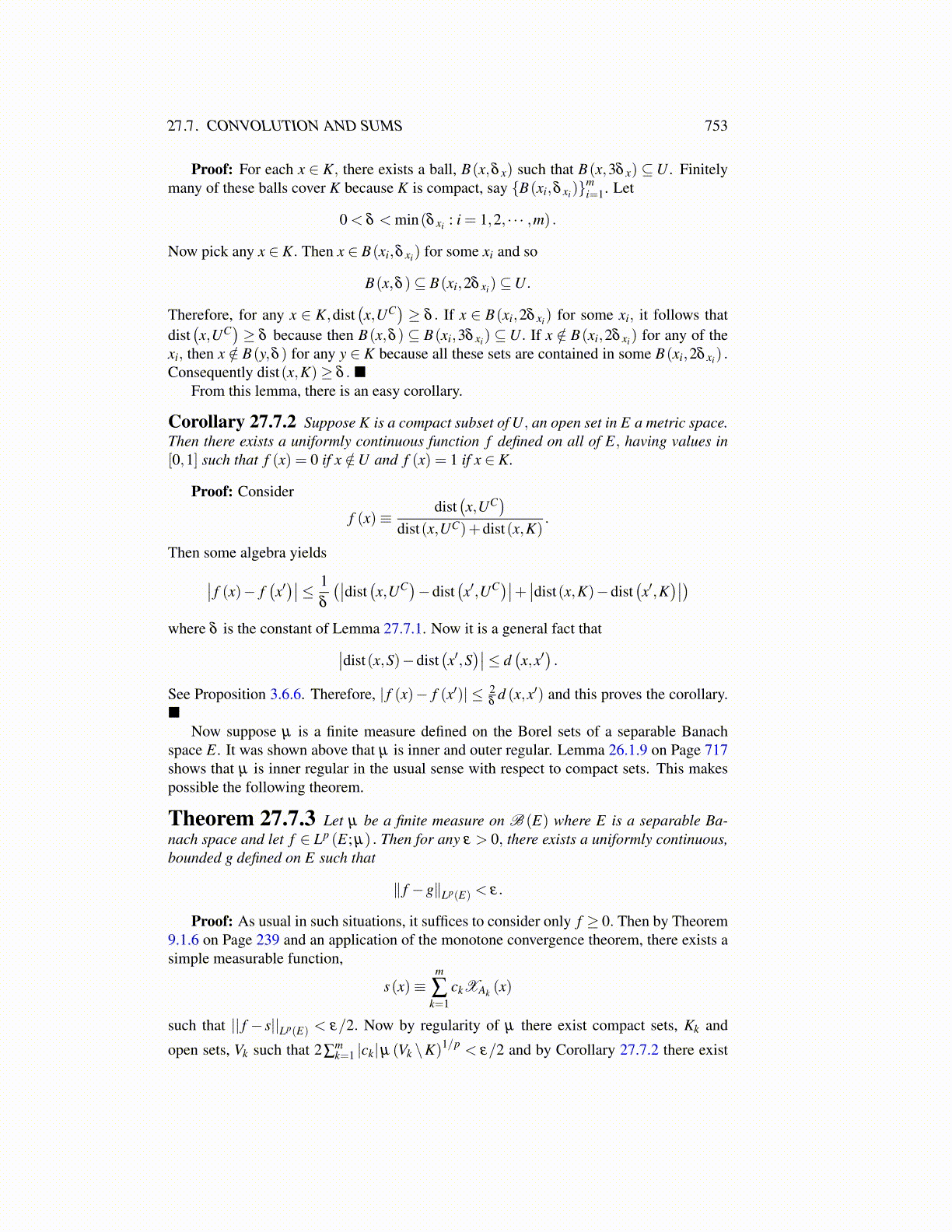
27.7. CONVOLUTION AND SUMS 753
Proof: For each x ∈ K, there exists a ball, B(x,δ x) such that B(x,3δ x) ⊆U . Finitelymany of these balls cover K because K is compact, say {B(xi,δ xi)}
mi=1. Let
0 < δ < min(δ xi : i = 1,2, · · · ,m) .
Now pick any x ∈ K. Then x ∈ B(xi,δ xi) for some xi and so
B(x,δ )⊆ B(xi,2δ xi)⊆U.
Therefore, for any x ∈ K,dist(x,UC
)≥ δ . If x ∈ B(xi,2δ xi) for some xi, it follows that
dist(x,UC
)≥ δ because then B(x,δ ) ⊆ B(xi,3δ xi) ⊆U. If x /∈ B(xi,2δ xi) for any of the
xi, then x /∈ B(y,δ ) for any y ∈ K because all these sets are contained in some B(xi,2δ xi) .Consequently dist(x,K)≥ δ . ■
From this lemma, there is an easy corollary.
Corollary 27.7.2 Suppose K is a compact subset of U, an open set in E a metric space.Then there exists a uniformly continuous function f defined on all of E, having values in[0,1] such that f (x) = 0 if x /∈U and f (x) = 1 if x ∈ K.
Proof: Consider
f (x)≡dist(x,UC
)dist(x,UC)+dist(x,K)
.
Then some algebra yields∣∣ f (x)− f(x′)∣∣≤ 1
δ
(∣∣dist(x,UC)−dist
(x′,UC)∣∣+ ∣∣dist(x,K)−dist
(x′,K
)∣∣)where δ is the constant of Lemma 27.7.1. Now it is a general fact that∣∣dist(x,S)−dist
(x′,S
)∣∣≤ d(x,x′).
See Proposition 3.6.6. Therefore, | f (x)− f (x′)| ≤ 2δ
d (x,x′) and this proves the corollary.■
Now suppose µ is a finite measure defined on the Borel sets of a separable Banachspace E. It was shown above that µ is inner and outer regular. Lemma 26.1.9 on Page 717shows that µ is inner regular in the usual sense with respect to compact sets. This makespossible the following theorem.
Theorem 27.7.3 Let µ be a finite measure on B (E) where E is a separable Ba-nach space and let f ∈ Lp (E; µ) . Then for any ε > 0, there exists a uniformly continuous,bounded g defined on E such that
∥ f −g∥Lp(E) < ε.
Proof: As usual in such situations, it suffices to consider only f ≥ 0. Then by Theorem9.1.6 on Page 239 and an application of the monotone convergence theorem, there exists asimple measurable function,
s(x)≡m
∑k=1
ckXAk (x)
such that || f − s||Lp(E) < ε/2. Now by regularity of µ there exist compact sets, Kk and
open sets, Vk such that 2∑mk=1 |ck|µ (Vk \K)1/p < ε/2 and by Corollary 27.7.2 there exist